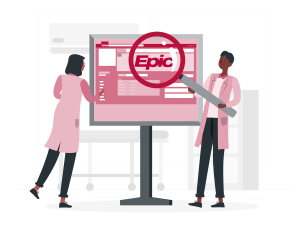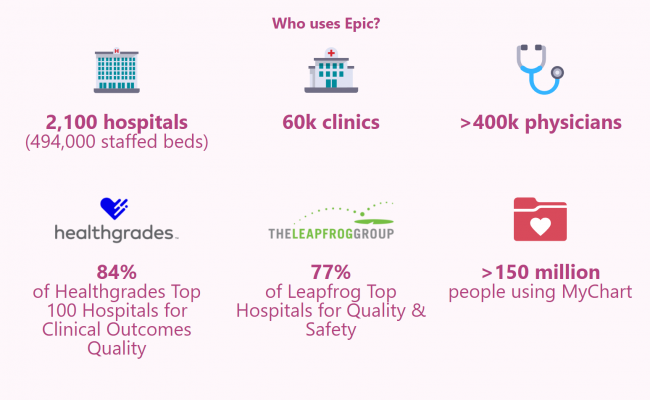
As the digital transformation sweeps across the healthcare industry, the need for robust and integrated Electronic Health Record (EHR) and Electronic Medical Record (EMR) systems has become paramount. These systems are at the heart of modern healthcare, facilitating efficient data exchange, improving clinical workflows, and ultimately, enhancing patient care outcomes. Among the myriad of EHR/EMR systems available today, Epic Systems stands out as a leading provider, with its robust suite of applications adopted by a multitude of healthcare organizations worldwide.
Epic’s EHR/EMR solutions, designed with interoperability in mind, play a vital role in the seamless exchange of Protected Health Information (PHI). They help organizations create a unified view of patient data, which is crucial in delivering personalized care and making informed medical decisions. Given the sensitive nature of PHI, ensuring its security and compliance with regulatory standards such as HITRUST is of utmost importance.
Whether you are a healthcare provider looking to implement an Epic solution or a company seeking to understand the intricacies of Epic EHR/EMR integration, this article written by a leading Seattle-based healthcare software development company Itirra will provide the key insights you need to begin a smooth and successful integration process.
What is Epic Systems? What is Epic software used for?
Epic Systems, founded in 1979 by Judith R. Faulkner, is a privately held healthcare software company that has established a significant presence in the global healthcare technology landscape. Headquartered in Verona, Wisconsin, Epic has been instrumental in transforming the way healthcare providers store, access, and exchange PHI.
Epic’s journey began with a focus on database management, which later evolved into developing comprehensive EHR/EMR systems, uniquely designed to meet the intricate needs of healthcare organizations. Epic’s EHR/EMR solutions are lauded for their interoperability, scalability, and user-friendly interfaces, accommodating a broad spectrum of healthcare settings ranging from large hospitals and academic medical centers to community health organizations and independent practices.
Epic’s EHR/EMR systems leverage industry-leading standards like Health Level Seven (HL7) and Fast Healthcare Interoperability Resources (FHIR) to facilitate seamless data exchange between different healthcare systems. The adoption of such standards has made Epic a frontrunner in the march towards healthcare interoperability, an essential aspect of modern healthcare delivery.
A cornerstone of Epic’s success lies in its commitment to security and compliance, with its software solutions conforming to HITRUST standards. This ensures that PHI is protected at all times, adhering to the stringent regulations outlined by the Health Insurance Portability and Accountability Act (HIPAA). Epic Systems has emerged as an industry-leading tool in healthcare management. Its influence extends far and wide, shaping the way healthcare providers manage and exchange critical patient information.

An overview of Epic EHR/EMR integration
Epic EHR/EMR integration represents a vital cog in the machinery of healthcare information management. This integration involves harmonizing disparate healthcare systems to create a unified, coherent data flow using Epic’s EHR/EMR solutions. With a successful Epic integration, healthcare organizations can achieve an interconnected network of systems where data is easily accessible, secure, and easily exchanged.
At the core of Epic’s EHR/EMR solutions are several critical components that facilitate effective data management. These include modules for patient registration and scheduling, clinical systems for doctors, nurses, emergency personnel, specialty applications for cardiologists, radiologists, pharmacists, and systems for lab technologists, surgeons, dietitians, and more. Each of these components is designed to interact seamlessly with one another, ensuring a smooth flow of information across all departments.
The technical aspects of Epic EHR/EMR integration involve adhering to industry-leading standards like HL7 and FHIR. HL7 provides the framework and standards for the exchange, integration, sharing, and retrieval of electronic health information. On the other hand, FHIR is a newer standard that makes use of modern web technologies to aid in the exchange of healthcare information. The use of these standards ensures that Epic’s EHR/EMR solutions can effectively communicate with other healthcare systems, regardless of their make or model.
In essence, Epic EHR/EMR integration marks a significant stride towards a future where data flows freely yet securely across the healthcare continuum, improving both patient care and operational efficiency. Partnering with seasoned developers can help you navigate this complex landscape and effectively harness the power of Epic’s EHR/EMR solutions.
What are the challenges with Epic EHR/EMR integration?
Epic EHR/EMR integration, while offering numerous advantages, is not without its set of challenges. These complexities arise from both technical and organizational aspects, which can pose significant hurdles for healthcare organizations striving for seamless integration. Understanding these challenges and being prepared to address them is crucial for achieving successful integration.
Navigating data standards and security regulations
One of the key technical challenges is the need to comply with various data standards and security regulations. Ensuring data security, especially in the context of PHI, is paramount. Epic’s EHR/EMR solutions are designed to be compliant with HITRUST standards and align with the data exchange protocols such as HL7 and FHIR. However, the implementation and maintenance of these standards and protocols can be complex, requiring specialist knowledge and skills.
Understanding the complexity of Epic's EHR/EMR solutions
Another challenge arises from the sheer complexity of Epic’s EHR/EMR solutions. With numerous modules catering to different aspects of healthcare management, the integration process can become complicated, especially when interfacing with other existing systems. It requires careful planning, testing, and execution to ensure all components interact as expected without disrupting the existing workflows.
Addressing organizational challenges
Organizational challenges are another aspect to consider. Change management can be a significant issue, as integrating a new system might require changes to existing workflows and processes. Training staff to use the new system effectively and addressing any resistance to change can also pose substantial challenges.
Leveraging expertise for successful integration
Overcoming these challenges requires a strategic approach, supported by robust technical expertise. Partnering with experienced developers, such as Itirra, can be invaluable in this regard. Their experience and expertise can help healthcare organizations navigate these complexities, ensuring a smooth and successful Epic EHR/EMR integration. By providing guidance on best practices, offering technical insights, and helping manage the change process, they can help transform these challenges into opportunities for enhanced patient care and operational efficiency.

What are the benefits of Epic EHR/EMR integration?
The benefits of a successful Epic EHR/EMR integration are manifold. First and foremost, it promotes a high degree of interoperability, ensuring that patient information can be accessed and updated across various systems in real time. This facilitates more accurate diagnoses, more effective treatment plans, and better patient outcomes. Furthermore, Epic’s commitment to HITRUST standards means that all PHI is safeguarded, reinforcing data security and compliance with HIPAA regulations. As healthcare continues to evolve, organizations that leverage these integrations will be better positioned to provide high-quality, patient-centric care.
Enhanced patient data management
One of the most significant advantages of integrating Epic EHR/EMR is the improvement in patient data management. Epic’s robust capabilities allow for the consolidation of patient data into a single, easily accessible record, enhancing the quality of care provided. Through integration, healthcare providers can access comprehensive patient information, including history, treatments, and tests, facilitating better decision-making and reducing instances of medical errors.
Streamlining workflows
Epic’s EHR/EMR integration also plays a crucial role in streamlining healthcare workflows. By facilitating seamless data exchange between different systems and departments, Epic integration can significantly reduce manual data entry and administrative tasks, enabling healthcare providers to focus more on patient care. Furthermore, through HL7 and FHIR protocols, data can be exchanged in real-time, accelerating service delivery and enhancing patient satisfaction.
Bolstering security measures
With the increasing concerns over data security and privacy, Epic’s EHR/EMR integration provides robust security measures in compliance with HIPAA and HITRUST standards. By encrypting PHI and implementing strict access controls, Epic ensures that patient data is safeguarded from unauthorized access or breaches, thereby fostering trust among patients and stakeholders.
Improved clinical decision making
The integrated, comprehensive view of patient information facilitated by Epic integration also supports improved clinical decision-making. Providers can access up-to-date, complete patient records, enabling them to make informed, evidence-based decisions about patient care. This can lead to improved patient outcomes, increased patient satisfaction, and a reduction in medical errors.
Operational efficiency and cost savings
Finally, Epic EHR/EMR integration can drive operational efficiency and cost savings. By eliminating manual data entry, reducing duplicate tests, and improving administrative workflows, Epic’s solutions can save healthcare providers significant time and resources. This, in turn, allows them to focus more on their core mission: providing high-quality patient care.
Conclusion
In the complex arena of healthcare, the importance of EHR/EMR integration cannot be overstated. As we’ve explored throughout this article, Epic Systems, with its robust and industry-leading solutions, offers a reliable path to successful integration, thereby helping healthcare organizations unlock numerous benefits. From enhancing patient data management and streamlining workflows to bolstering security measures, Epic’s EHR/EMR integration stands as a cornerstone of efficient and secure healthcare operations.
However, it’s crucial to remember that the path to successful integration isn’t always straightforward. It requires careful planning, skilled resources, and expert guidance to navigate the inherent challenges. This is where Itirra, as a leading healthcare software development company, steps in.
With our deep expertise in Epic EHR/EMR integration and a firm commitment to delivering the highest quality solutions, we help healthcare organizations navigate the complexities of integration, ensuring they are well-positioned to thrive in the evolving healthcare landscape. To learn more about how Itirra can assist your organization in achieving successful Epic EHR/EMR integration, feel free to reach out to us. Together, we can help shape a future where technology drives improved health outcomes for all.

